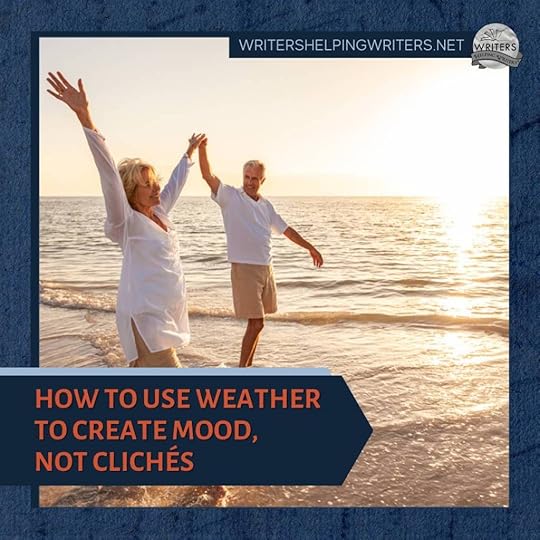How to Use Weather to Create Mood, Not Clich��s

Are you afraid of using the weather in your writing? If so, you’re not alone. After all, if not careful, weather description can be a minefield of clich��s. The sunny, cloudless afternoon at the beach. The gloomy rainstorm at a funeral. Overdone setting and weather pairings can lie flat on the page.
Then there’s the danger that comes with using weather to mirror a character���s inner emotional landscape. Mishandling this technique can quickly create melodrama. We’ve all read a battle scene where lightning crackles as our protagonist leaps forward to hack down his foe in desperation. And how about that turbulent teen breakup where the character’s tears mix with falling rain? Unfortunately these have been used so much that most readers tilt their head and think, Really? when they read a description like this.
Agents and editors on first page panels never fail to reject a few openings that start with the weather, either. Why? Because done poorly, it comes across like a weather report, and delays the introduction of the hero. Readers are not always patient and we should strive to introduce our characters and what they are up against as soon as possible.
Wow, weather sounds like a recipe for disaster, doesn’t it? It���s no wonder that some writers are so nervous about using it they cut it from their manuscript. But here���s the thing���avoiding weather in fiction can be a fatal mistake.
Make Weather Your FriendWeather is rich. Powerful. It is infused with symbolism and meaning. And most of all, weather is important to us as people. We interact with it each day. It affects us in many subtle ways. In fact, let���s test this by walking in a character���s shoes.
Think about walking down a street. It���s late afternoon, crystal bright, and a hot breeze blows against you. School���s out and kids run willy-nilly down the sidewalk, laughter ringing the air as they race to the corner store for a grape slush. Your sandals click against the pavement as you turn down between two brick buildings. The side door to an Italian restaurant is just past a rusty dumpster, and your fianc��e���s shift is about to end. You smile, feeling light. You can���t wait to see him.
Now, let���s change the scene.
It���s sunset, and the weather has soured. Dark clouds pack the sky, creating a churning knot of cement above you. The sidewalk is deserted, and the wind is edged in cold, slapping your dress against your legs as you walk. You wish you���d worn pants, wish you���d brought a sweater. In the alley, garbage scrapes against the greasy pavement and the restaurant���s dumpster has been swallowed by thick shadow. The side door is only a few steps away. You can���t quite see it, and while all you have to do is cross the distance and knock, you hesitate, eyeing the darkness.
The same setting, the same event. Yet, the mood and tone shifted, all because of the weather I included in the backdrop. What was safe and bright and clean became dark and alien. This the power of weather–changing how people feel about their surroundings.
Steering Your Reader’s EmotionsReaders bring the real world with them when they enter a story. Avoiding weather description will be noticed as it’s such a natural part of the everyday, and it becomes a missed opportunity to steer how our readers feel.
Weather is a tool to evoke mood, guiding the character toward the emotions we want them to feel, and by extension, the reader as well. By tuning into specific weather conditions, a character may feel safe, or off balance. Weather can work for or against the character, creating conflict, tension, and be used to foreshadow, hinting that something is about to happen.
Because we have all experienced different types of weather ourselves, when we read about it within a scene, it reminds us of our own past, and the emotions we felt at the time. So, not only does weather add a large element of mood to the setting, it also encourages readers to identify with the character���s experience on a personal level.
How Do We Write Weather in a Clear Way and Stay Away From Pitfalls?Use Fresh, Sensory Images. In each passage, I utilized several senses to describe the effects of the weather. A hot breeze. Garbage scraping against the greasy pavement. A wind edged in cold, slapping against the legs. By describing weather by sound, touch and sight, I was able to make the scene feel real.
Avoid Direct Emotion-to-Weather Clich��s. There are some pairings we should avoid as I mentioned above, and with so many different types of weather elements we really need to think past the usual ones. Avoid mirroring and instead show the character���s reaction to the weather. This is a stronger way to indicate their emotions without being too direct.
Choose Each Setting with Care. Setting and Weather should work together, either through contrast or comparison. In the first scene, we have beautiful weather and an alley as a final destination. These two are contrasts���one desirable, one not, but I chose to show enthusiasm and anticipation for the meeting to win out. In the second, the weather becomes a storm. Now we have two undesirable elements, and as such, they work together to build unease.
Weather can have a positive or negative effect on setting and change the character���s reaction to it, so don���t be afraid to use it! Just remember that with something this powerful, a light touch is all that is needed.
Would you like help brainstorming descriptions for different types of weather?
Check out our comprehensive Weather Thesaurus at One Stop for Writers. There you can access all sorts of weather phenomenon, and the sights, smells, sounds, tastes and textures that will help you show, not tell, building in the exact emotional mood you want for each scene.
Great news! Check out this post to get 25% off any One Stop for Writers plan through September 25, 2025!
How do you use weather in your stories?The post How to Use Weather to Create Mood, Not Clich��s appeared first on WRITERS HELPING WRITERS��.
Writers Helping Writers
- Angela Ackerman's profile
- 1016 followers



